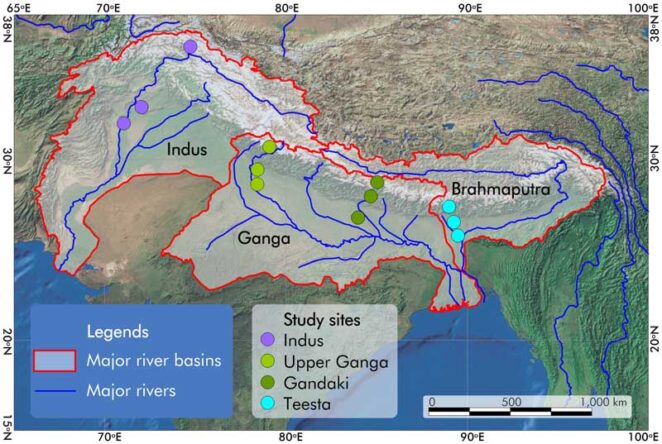Himalayan Adaptation, Water and Resilience (HI-AWARE) Research on Glacier and Snowpack Dependent River Basins for Improving Livelihoods

HI-AWARE completed in 2018. Read the final report: Himalayan Adaptation, Water and Resilience Research (HI-AWARE) : Highlights Report (2014-2018).
Read more about HI-AWARE on the Adaptation at Altitude Solutions Portal.
Introduction
The Hindu Kush Himalayan (HKH) region, the source of ten large river systems of Asia, provides water and other ecosystem services to more than 210 million people living in the mountains and over 1.3 billion living in the plains. That is why these sources in the HKH region are also known as the ‘Water Towers of Asia’. Characterised by the youngest, highest and some of the most fragile mountain systems in the world, the HKH region and its glacier- and snow- fed river basins are highly vulnerable to climate change impacts.
Climate change-induced shifts in the timing and pattern of rainfall, especially monsoon rainfall, and of glacier and snow runoff in the region, are already having an impact on water resources, including water availability and energy security across the region. As most of the HKH region, including the Indo-Gangetic plains, is dependent on monsoon rain for agriculture, any changes in the monsoon cycle are going to have implications for food and nutritional security in the region. The impacts of climate change can be especially difficult to cope with for vulnerable populations, many of whom are dependent on subsistent farming. The impacts created by changing weather patterns, for example, can adversely impact agricultural output.
Adaptation measures and strategies, based on traditional and indigenous knowledge, and informed by modern science, are needed. However, we do not know enough about the local, seasonal, and sectoral impacts of climate change; nor do we know enough about how people are adapting, and what adaptation measures work – when, for whom, and at what scale.
HI-AWARE, one of the four consortia of the Collaborative Adaptation Research Initiative in Africa and Asia (CARIAA), aimed to address some of these knowledge gaps as well as influence policy and practice to increasing the climate resilience and adaptive capacities of vulnerable people and their surrounding systems. It conducted research and pilot interventions, capacity building and policy engagement on climate resilience and adaptation in the mountains and flood plains of the Indus, Ganges, and Brahmaputra river basins, with the overall goal of using the findings to improve local livelihoods.]
HI-AWARE completed in 2018. Its resources can still be accessed on the HI-AWARE website.

Objectives, Methods and Tools
HI-AWARE:
- Generated scientific knowledge on the biophysical, socio-economic, gender, and governance conditions and drivers that lead to people’s and region’s being vulnerable to the effects of climate change;
- Developed robust evidence to improve understanding of the potential of adaptation approaches and practices, with an explicit focus on gender and livelihoods;
- Developed stakeholder-driven adaptation pathways based on the up- and out- scaling of institutional and on-the-ground adaptation innovations;
- Promoted the uptake of knowledge and adaptation practices at various scales by decision-makers and citizens; and
- Strengthened the interdisciplinary expertise of researchers, students and related science and policy stakeholder networks.
HI-AWARE implemented three Work Packages—Knowledge Generation, Research into Use, and Strengthening Expertise—in 12 sites in the Indus, Upper Ganga, Gandaki and Teesta river basins. The sites are located in Hunza, the Soan River basin, Mona and Sargodha in Pakistan; Garhwal and between Rishikesh and Roorkee in India; Langtang and Nuwakot in Nepal; and the Gandaki floodplain in Nepal; and West and North Sikkim; Darjeeling, Kalimpong, Gangtok; and Jalpaiguri district in India. There is also one site in Niphamari district in Bangladesh.
- Generating Knowledge (GK) focused on the generation of scientific knowledge to address major research gaps that are currently preventing the support of planned adaptation, especially in areas such as food and agriculture, energy, health and nutrition, urban habitat, and hazards management. GK, in turn, consists of five inter-related research components. Read more here.
- Research into Use (RiU) focused on promoting the uptake of research among key stakeholders, particularly practitioners, policymakers, and vulnerable communities, to improve the livelihoods of vulnerable populations in the region. Whether the research will be used by the stakeholders depends on three overlapping factors: political/policy contexts; strength of evidence; and quality of relationships between policymakers, practitioners, and research communities. Read more here.
- Strengthening Expertise (SE) focused on building the capacity of MSc/PhD students, research institutes and NGOs from the region for conducting interdisciplinary research on climate change vulnerability, adaptation and resilience. Read more here.
In addition to conducting research on water, energy, food security, human health, water-induced hazards—such as floods, landslides and droughts—and extreme weather events, HI-AWARE also tested adaptation measures in observatory labs in these sites and designed adaptation pathways for out-scaling and up-scaling.
Read the latest news from HI-AWARE here.
Programme outputs
- Explore regional hazards, data, solutions and Story Maps from HI-AWARE on ICIMOD’S Mountain-Geoportal.
- Browse working papers, peer-reviewed journal articles, andblogs produced by HI-AWARE on HimalDoc:https://lib.icimod.org/search?page=1&size=20&q=hi-aware
- Read the final report: Himalayan Adaptation, Water and Resilience Research (HI-AWARE) : Highlights Report (2014-2018)
(0) Comments
There is no content